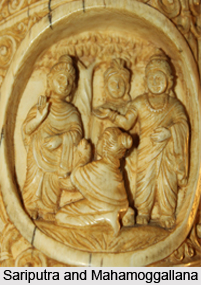 Relics of Sariputra and Mahamoggallana have been discovered by the Archaeological Survey of India in a few Indian Stupas. Sariputra and Mahamoggallana were the two prime disciples of Gautama Buddha, who died one after another within a span of two weeks. After their cremation, their relics were initially preserved which in due course of time lost to the developing civilizations.
Relics of Sariputra and Mahamoggallana have been discovered by the Archaeological Survey of India in a few Indian Stupas. Sariputra and Mahamoggallana were the two prime disciples of Gautama Buddha, who died one after another within a span of two weeks. After their cremation, their relics were initially preserved which in due course of time lost to the developing civilizations.
In the year 1851, when the Asokan Buddhist complex in Sanchi, Madhya Pradesh, was being excavated by Sir Alexander Cunningham; the bodily relics of Sariputra and Mahammoggallana were recovered from the third Stupa. Further relics were discovered from a Stupa at Satadhara, located a few kilometres away from Sanchi. From the centre of the Stupa at Sanchi, a large stone slab was unearthed, having a length of more than five feet. Two grey sandstone boxes were found beneath the slab with Brahmi inscriptions on their lids. The box found at southern end had "Sariputtasa" inscribed on it which means `Relics of Sariputra` whereas the box towards the north had the inscription "Maha-Mogalanasa" which refers to `Relics of Mahamoggallana`.
Artefacts in the Relics of Sariputra and Mahamoggallana
The box of Sariputra was found to contain a white steatite casket, having a width of six inches and a height of three inches. The box was believed to be made on lathe, with hard and polished surface having beautiful artistry. Fragments of sandalwood surrounded the casket, which were probably from the funeral pyre, whereas inside the box some precious gemstones were also found. A single bone relic of Sariputra has also been found which is shorter than an inch. Stone box of Mahamoggallana contained another steatite casket, slightly smaller than the previous one and had a soft surface.
Two bone relics of Mahamoggallana have been recovered from the box. Single ink letter inscriptions have been found on the lids of each casket having the characters "Sa" for Sariputra and "Ma" for Mahamoggallana. It has been inferred that they were the chief disciples of Lord Buddha who were usually styled as his right and left hand disciples. Thus, after their death their ashes had been preserved in the same positions that they occupied in the life of Lord Buddha.
Two more caskets made of pale mottled steatite were also discovered at the Satadhara Stupa, one among a group identified by Cunningham, which was locally referred as Buddha Monuments or Buddha Bhita. Like the caskets found at Sanchi, these also had inscriptions of "Sariputtasa" and "Mahamogallanasa". These caskets bear the marks of tampering by burglars, however the relics of bones have been found undisturbed.
Display of the Relics of Sariputra and Mahamoggallana
The sacred relics discovered were initially taken to England for preservation and were placed in the Victoria and Albert Museum. These were kept there until 1939, after which the Maha Bodhi Society approached the British government and requested for the return of the relics to India. Although the request was granted, its implementation got delayed owing to the Second World War. The transfer ultimately occurred on 24 February 1947 safely. Before reaching India, the relics were also taken to Sri Lanka and Colombo Museum where it received great fanfare. Later they were taken to Calcutta for display in at the Dharmarajika Vihara, headquarters of the Maha Bodhi Society of India. After this, the relics also had a tour of Burma followed by a trip of Nepal and Ladakh. After their final return to India, a portion of it was demanded by the Burmese government to which the Maha Bodhi Society agreed. It was transferred in a ceremonial event in October 1950. Another portion of the relics was enshrined in a new Stupa of Sri Lanka which was constructed by the Maha Bodhi Society of Sri Lanka. The rest were enshrined in at Sanchi on completion of the new Chetiyagiri Vihara on 30 November 1952, which was built exclusively for storing them.



















